Smoke
Today is a play day. We're not going to tackle any big issues about making art or about selling art. We're not going to talk about resistance or what work style is best for creative people. We're not going to change the world. Today we are going to relax and charge our batteries with a topic that, while not technically about art at all, is one of the most remarkable and energizing phenomena that I know anything about. And energizing our spirits, recharging our batteries, and centering our hearts is something that is very important. Without time spent to refresh and renew and clear our heads, we lose our way.
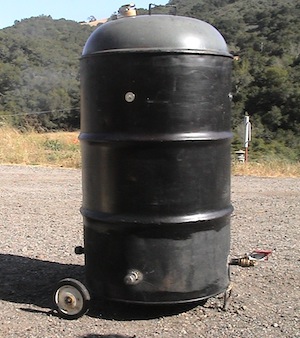
Today I put most of the finishing touches on my new Ugly Barrel Smoker. It's a 55 gallon drum with a fire box that can hold about 15 pounds of charcoal, a grill to hold meat, some vents for air, and a repurposed Weber barbecue lid. I fired it up today to see how well it holds temperature, and 5 hours later it is still steady at 250 degrees Farenheit. I think it's going to work. Next test will be a brisket, probably tomorrow. But the smoker is not what we are going to talk about today. I bring it up because as I watched the thermometer in the top today to see how well it would hold temperature, I was downwind of the whisps of smoke that wafted gently out of the vents. The smoke reminded me of honeybees and beekeeping. As I hung out in the smoke I got the idea for what we will talk about now.

There's a picture of my smoker on the left. It's been around for a long time. It was my second smoker. I have a spare still in the box, but might not ever wear this one out. I have never heard an adequate explanation for why smoke calms honeybees. The folk wisdom is that the bees, thinking there is a fire nearby, are focused on a threat and problem that they cannot sting their way out of. Rather than getting defensive, they all engorge their honey stomachs and prepare for an emergency exit. I'm not so sure about this explanation, and have never read literature about any studies confirming it. But smoke does calm bees. Remarkably so! In fact, I routinely open a beehive with no protective gear, but not if I don't have access to a lit smoker!
The Observation Hive

Late this spring, I had the chance to capture a swarm. I had no extra boxes on hand, so I put the swarm into my observation hive. This is a tall thin box with glass sides. It holds three standard frames of comb in such a way that both sides of each comb are visible under glass. The bees are happy enough with this arrangement, and it's a great way to watch and learn about the life of the hive.
I've toted this observation hive to schools and fairs and talked to countless people who were eager to peer through the glass and try to find the queen. The observation hive is in my studio, with a secure passage through a window to the outside. It allows me to watch the amazing natural history of the beehive for extended periods without disturbing the bees. For example, I can watch and interpret the nectar dance, which tells the bees in the hive which direction, how strong, and how far away a food source is. Knowing this dance, and how to read it is very helpful to me as I try to plan how I will manage the hives in my apiary.
I can also practice locating the queen, an excercise that's akin to the "Where's Waldo?" puzzles that were popular a few years back. I can easily monitor the hatch of fuzzy new bees from the brood comb and evaluate the rate at which nectar is being stored. I can look for newly laid eggs, and monitor the development of larvae. And I can observe the mystery of comb production. You never see a bee "building comb." As if by magic, comb grows at a pace undetectable to the observer, much like the way a plant grows. When there is no place to store the nectar they carry in their honey stomachs for more than a couple of days, bees convert the nectar to small flakes of wax which are secreted from six glands on the back of their abdomen. Those flakes are randomly added to comb in what seems to be a totally haphazard fashion. It is truely remarkable that this apparent chaos results in perfect hexagons of uniform size.
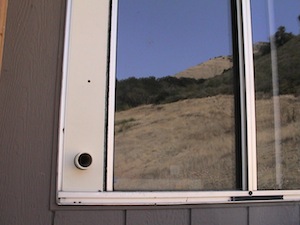
The Observation hive, with its outdoor exit, is a fully functional but small beehive that will keep the bees happy until they decide to swarm due to overcrowding. With only three frames to work with, this will be soon. I'll watch the swarm preparations, then intervene to solve the problem just in time to prevent the loss of the swarm. This sort of intervention is part of what beekeeping is all about, and it's easy to do when you can watch the process under glass.
Swarms
A swarm is a new honeybee colony looking for a home.
When an established colony gets too crowded,
the workers build queen cells and begin preparations to swarm.
A couple of days before the new queens are due to hatch, the old queen
leaves the hive with approximately half of the bees to seek a new
home.
The other half of the bees stay and wait for their new queen to emerge.
Once the swarm leaves, the crowded condition is relieved and the hive
continues on with the remaining bees.
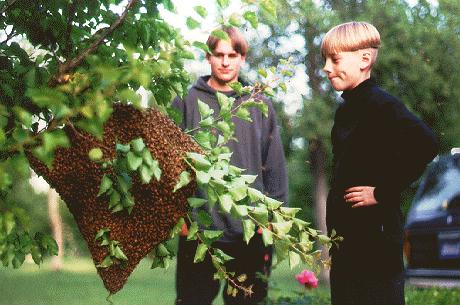
Quite often, the bees have not yet decided on a location for their
new home when the swarm emerges.
When this happens, they stop to rest out in the open.
This is usually when people encounter a swarm.
The bees cluster around the queen in a big clump and wait
for the scout bees to find a suitable home.
If all goes well they will find a place to their liking
and move into it within hours or days.
In some cases, no place is found and they make their home in the
place where they are clustered.
The swarm picture here is the biggest swarm I have ever seen,
and weighs in at 26 pounds! I named it the Subcontinent of India. Big ones like this are
referred to as barrel swarms.
As a general rule, a swarm is less likely to sting than an
established colony.
This is because honeybees sting to protect their home, and
a swarm is a colony without a home to protect.
Many beekeepers don't routinely wear protective gear to capture swarms.
There are some exceptions to this general rule.
If you try to drive the swarm away by throwing rocks or spraying it
with a hose, you risk invoking the second reason that bees sting—to protect themselves.
When they feel threatened or trapped, they sting.
The most common way to get stung by a swarm that you aren't bothering
is to walk through it while it's still flying. There can be as many as
30 or 40 thousand bees
swirling
in a 20 foot circle around the queen in flight, and if you walk into
it you
are bound to get bees caught in your hair or clothing. Once caught,
they will sting in an attempt to escape.
Bee Space
The reason that we can manage a beehive as easily as we do, and even do something as crazy as to put a beehive under glass, is something called bee space. Bee space is the crawl space the bees maintain between and around the comb.
The dimensions of bee space are between 3/16 inch and 5/16 inch.
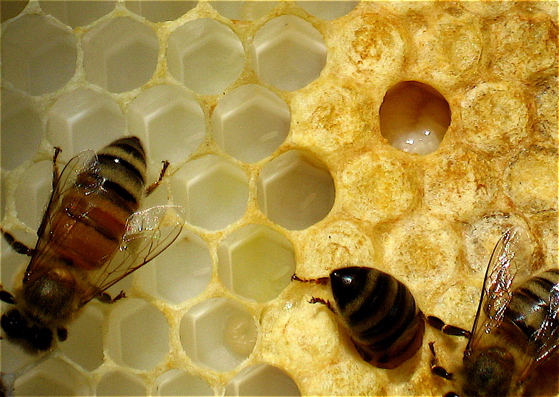 If the space is narrower than 3/16 inch, the bees seal it with propolis,
a caulking material consisting of resins, wax, and plant fibers.
If the space is larger than 5/16 inch, the bees build comb across it.
By keeping all designed spaces between the frames and hive walls within the
limits of bee space, we prevent the bees from locking all of our equipment
into a solid block of wax, honey and wood. This is a remarkable fact that makes modern beekeeping possible. It was discovered in the late 19th century by a guy named Willam Langstroth.
If the space is narrower than 3/16 inch, the bees seal it with propolis,
a caulking material consisting of resins, wax, and plant fibers.
If the space is larger than 5/16 inch, the bees build comb across it.
By keeping all designed spaces between the frames and hive walls within the
limits of bee space, we prevent the bees from locking all of our equipment
into a solid block of wax, honey and wood. This is a remarkable fact that makes modern beekeeping possible. It was discovered in the late 19th century by a guy named Willam Langstroth.
Honey
Honey is condensed nectar from flowers.
It contains very little moisture, and is an assortment of simple sugars.
It takes about 12-13 pints of nectar to make 1 pint of honey.
The bees put the nectar in open cells of comb and fan it with their
wings to drive off the excess moisture. When the moisture content is
right,
they seal each cell with a wax cap to store it for future use.
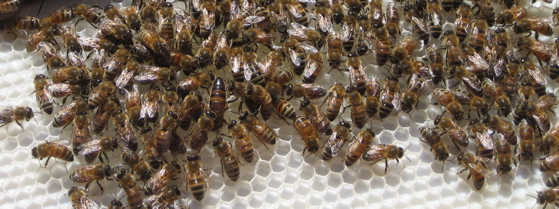
There is a popular misconception that pollen is an ingredient of
honey. There can be trace amounts of pollen mixed into honey, but it's
not actually part of the honey. Pollen is the primary protein,
fat, and mineral source for the bees, while honey is almost
pure carbohydrate sugars.
Because of its extremely low moisture content, honey will keep
indefinitely.
In fact, still edible honey has been found in the burial chambers of
Pharaohs in Egypt!
The secret of honey's preservative power is that it contains far less
moisture than yeasts and bacteria do.
It literally sucks the moisture out of
bacteria, killing it in the process. A few types of bacteria have a
casing around them that protects their moisture from honey, but
they can only survive, but not thrive in honey.
To multiply and thrive they must break through the protective
shell, and that requires a higher moisture level than honey
provides.
Since it's so dry, honey acts as a moisture magnet. It will absorb
humidity from the air, and can become moist enough to ferment in humid conditions.
There's no legal definition for raw honey in the United States.
I consider honey to be raw if it hasn't been heated above
120 degrees Farenheit. It's unlikely that
honey would ever be exposed to temperatures higher than that
anywhere in nature. And beeswax, which is the natural storage container for
honey, melts a little above 120 degrees Farenheit. A stricter definition of raw is a maximum heating to 95 degrees. That's about the highest
temperature honey will ever see if it stays inside a beehive, which is where it
really belongs. In fact, in the beehive, honey is kept at about that temperature
all the time, regardless of the weather, suggesting that 90-95 degrees is probably the only proper temperature
for honey. But that's a bit tricky for most of us to achieve.
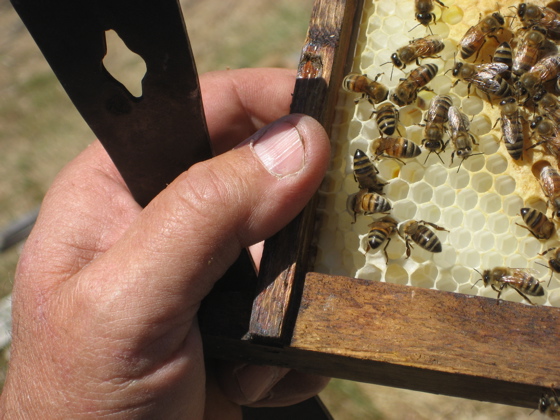
Why, you ask, is this important?
The floral aromatics in honey deteriorate when it's heated. The bees
maintain the interior of the hive at about 92 degrees, and that temperature
doesn't seem to be detrimental to the delicate flavor of honey.
But even heating honey to 120 degrees for an extended period will begin to
affect its flavor adversely.
Just remember when reading the label that there is no legal
standard for raw honey.
A bottler could boil their honey and still put the word 'raw' on the label.
Your best bet for quality honey is to buy local,
know the producer, and ask specific questions about how the honey was processed.
The Mystery and the Magic
Keeping bees is one of the most remarkable things I have ever experienced. I sense an energy that I can only describe as mystical when I am in the presence of a colony of honeybees. I draw strength and calm and energy from my time with the bees that nothing else can provide. It's different from making art. I am not creating when I interact with the bees. I am simply in their presence. I keep bees for this reason. I live in a microclimate that doesn't usually provide a long enough nectar flow before the summer drought to provide me with extra honey to harvest. Most years I leave all the honey on the hives so they can get through to the next rainy season. But honey is not my reason to keep bees. I wrote a short piece about this long ago. You can read it here."
In addition to this mystical aspect, there is also Magic. Magic is different from Mystery. Magic is the knowing of things hidden. Beekeepers are magicians in this sense because we have studied and learned first hand, the ways of the bees. We know things that are hidden from the common man, not because they are secret, but because the average person will not risk a sting to learn them. Many seasoned beekeepers use little or no protective gear when working with their bees.
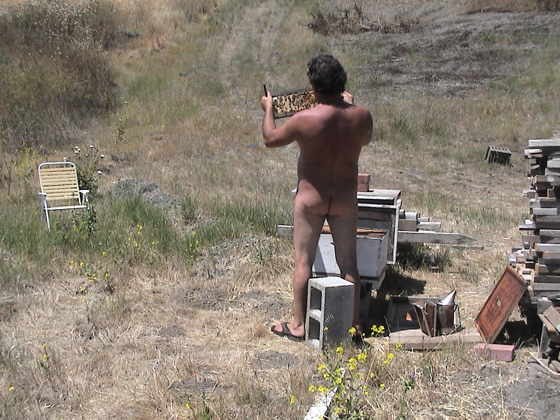 This is because they know the way of bees. They know the signs that all is well or that something is amiss. An experienced beekeeper reads the early signs of defensiveness and acts accordingly, rarely triggering a serious incident. And any beekeeper worth his or her salt takes a sting from time to time without concern. In the past couple of years I have begun a meditative practice that keeps me focused and tuned to the bees more clearly when I am with them. The picture here should give you an idea what it's all about.
This is because they know the way of bees. They know the signs that all is well or that something is amiss. An experienced beekeeper reads the early signs of defensiveness and acts accordingly, rarely triggering a serious incident. And any beekeeper worth his or her salt takes a sting from time to time without concern. In the past couple of years I have begun a meditative practice that keeps me focused and tuned to the bees more clearly when I am with them. The picture here should give you an idea what it's all about.
I have shown you the tip of the iceberg. I could probably talk for six hours straight about honeybees without substantially repeating myself. It's one of my favorite topics. It was perhaps a bit indulgent for me to stray from our usual subject matter to share this with you today, but as I said at the start, sometimes it's good to get off the path and wander into restful and inspiring places. This for me is one of those. I hope it has been for you as well.
| 





 If the space is narrower than 3/16 inch, the bees seal it with propolis,
a caulking material consisting of resins, wax, and plant fibers.
If the space is larger than 5/16 inch, the bees build comb across it.
By keeping all designed spaces between the frames and hive walls within the
limits of bee space, we prevent the bees from locking all of our equipment
into a solid block of wax, honey and wood. This is a remarkable fact that makes modern beekeeping possible. It was discovered in the late 19th century by a guy named Willam Langstroth.
If the space is narrower than 3/16 inch, the bees seal it with propolis,
a caulking material consisting of resins, wax, and plant fibers.
If the space is larger than 5/16 inch, the bees build comb across it.
By keeping all designed spaces between the frames and hive walls within the
limits of bee space, we prevent the bees from locking all of our equipment
into a solid block of wax, honey and wood. This is a remarkable fact that makes modern beekeeping possible. It was discovered in the late 19th century by a guy named Willam Langstroth.


 This is because they know the way of bees. They know the signs that all is well or that something is amiss. An experienced beekeeper reads the early signs of defensiveness and acts accordingly, rarely triggering a serious incident. And any beekeeper worth his or her salt takes a sting from time to time without concern. In the past couple of years I have begun a meditative practice that keeps me focused and tuned to the bees more clearly when I am with them. The picture here should give you an idea what it's all about.
This is because they know the way of bees. They know the signs that all is well or that something is amiss. An experienced beekeeper reads the early signs of defensiveness and acts accordingly, rarely triggering a serious incident. And any beekeeper worth his or her salt takes a sting from time to time without concern. In the past couple of years I have begun a meditative practice that keeps me focused and tuned to the bees more clearly when I am with them. The picture here should give you an idea what it's all about.

